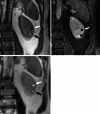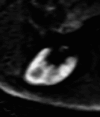MRI of the kidney-state of the art
- PMID: 17646992
- PMCID: PMC2039780
- DOI: 10.1007/s00330-007-0701-3
MRI of the kidney-state of the art
Abstract
Ultrasound and computed tomography (CT) are modalities of first choice in renal imaging. Until now, magnetic resonance imaging (MRI) has mainly been used as a problem-solving technique. MRI has the advantage of superior soft-tissue contrast, which provides a powerful tool in the detection and characterization of renal lesions. The MRI features of common and less common renal lesions are discussed as well as the evaluation of the spread of malignant lesions and preoperative assessment. MR urography technique and applications are discussed as well as the role of MRI in the evaluation of potential kidney donors. Furthermore the advances in functional MRI of the kidney are highlighted.
Figures









References
-
- Huang AJ, Lee VS, Rusinek H (2004) Functional renal MR imaging. Magn Reson Imaging Clin N Am 12:469–486 - PubMed
-
- Martirosian P, Klose U, Mader I, Schick F (2004) FAIR true-FISP perfusion imaging of the kidneys. Magn Reson Med 51:353–361 - PubMed
-
- Niendorf ER, Grist TM, Lee FT Jr, Brazy PC, Santyr GE (1998) Rapid in vivo measurement of single-kidney extraction fraction and glomerular filtration rate with MR imaging. Radiology 206:791–798 - PubMed
-
- Hackstein N, Kooijman H, Tomaselli S, Rau WS (2005) Glomerular filtration rate measured using the Patlak plot technique and contrast-enhanced dynamic MRI with different amounts of gadolinium-DTPA. J Magn Reson Imaging 22:406–414 - PubMed
-
- Pedersen M, Dissing TH, Morkenborg J et al (2005) Validation of quantitative BOLD MRI measurements in kidney: application to unilateral ureteral obstruction. Kidney Int 67:2305–2312 - PubMed
Publication types
MeSH terms
LinkOut - more resources
Full Text Sources
Other Literature Sources
Medical

